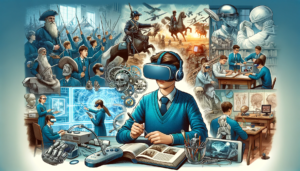The broad subject of “Virtual Reality Travel Experiences,” which examines the significant influence of virtual reality (VR) technology on changing teaching approaches and experiences, is perfect for your website. The essay will explore how virtual reality (VR) is used to build immersive, captivating, and compelling educational environments in various academic subjects.
- Overview of Pedagogy Using Virtual Reality
An overview of virtual reality technology and its growing integration into educational contexts will be given in the introduction. It will include background information on how virtual reality (VR) transforms education by offering immersive, engaging, and unforgettable learning experiences.
- VR’s Historical Development in Education
This section will follow the evolution of virtual reality technology across time, emphasizing how it is used in educational environments. It will draw attention to the shift from conventional teaching techniques to more dynamic and captivating online learning environments.
- VR Learning’s Mechanisms
The technological features of VR in teaching will be covered in detail in this essay. It will go over how virtual reality operates, the different kinds of VR devices that are out there, and the unique qualities that make VR a helpful teaching tool.
Fourth, Immersion Education Throughout Subjects
This section will examine the use of virtual reality (VR) in various academic fields, including science, art, history, and language acquisition. Instances of how virtual reality (VR) is utilized to replicate historical occurrences, natural phenomena, creative works of art, and cultural encounters will be given.
- Virtual Reality for Specialized Training
This section focuses on specialized instruction and will review how virtual reality is changing industries, including engineering, medical education, and flight instruction. It will discuss how virtual reality (VR) simulations offer secure, lifelike training settings.
- Improving Education’s inclusive and Accessibility
The following will focus on how virtual reality enhances Accessibility and inclusivity in academia. It will review how VR can accommodate various approaches to Learning and requirements, increasing educational equity and Accessibility for learners of various backgrounds and skill levels.
- VR’s Place in International Education
Here, the emphasis will move to virtual reality’s ability to link students worldwide. It will discuss how virtual reality (VR) helps students interact with classmates worldwide, investigate global issues, and experience various cultures and viewpoints.
- Issues and Things to Think About in VR-Based Learning
This section will cover the difficulties and factors to be considered when integrating virtual reality (VR) in educational settings, such as the necessity for customized content development, financial consequences, and technological obstacles.
- Case Studies: Effective VR Instructional Initiatives
The article will include several examples of practical VR education efforts and projects. These illustrations will highlight the usefulness and influence of VR in augmenting educational opportunities.
- VR Learning’s Psychological Effects
We’ll talk about the psychological components of VR learning in this part. The impact of virtual reality on motivation, engagement, retention, and the learning process will be covered.
- Trends and Opportunities for VR Education in the Future
Here, the Future of virtual reality in education will be discussed, along with new directions and possible trends. It will make assumptions about how technology is developing and how VR experiences in education are becoming more and more prevalent.
- Safety and Ethical Issues in Virtual Reality Education
The ethical and security aspects of VR in the classroom will be discussed in this section. It will go over how crucial it is to ensure VR material is user-safe, age- and culturally appropriate, and suitable.
- Conclusion: Using VR to Shape Education’s Future
The main ideas will be outlined in the conclusion, emphasizing how VR will change education in the Future. It will highlight how VR can produce inclusive, productive, and engaging learning environments for students worldwide.
This thorough investigation will highlight virtual reality’s role in changing the educational landscape by offering insights into its future possibilities
and an in-depth look at how it is already used in education
.